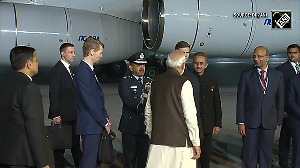Most people will agree that you don't need to be an expert to realise the problems plaguing education in India: That our system emphasises learning by rote, that most schools do not encourage a child to nurture and develop his/her true potential, that India faces an acute shortage of quality teachers, that there is very little cutting edge research happening in the country.
But when these truths are pressed home by a distinguished panel, like they were on Sunday as part of a session at the ongoing 16th Asian Corporate Summit organised by the Asia Society, you hope that the powers that be would take note and take action.
At a Summit marked by an overwhelming bullishness about India, the session on Education Reform: India's Path Towards World Class Status was one of the few warning bells.
Mahipal University Managing Director Gopal Rajagopalan, the moderator of the discussion, outlined what he called the "10 million problem."
Every year, 10 million students passed out of the 10 + 2 system of school education in the country, he said. Traditional brick and mortar systems of higher education could not cope with such a large number of entrants every year. It is in this context that distance learning and Internet institutions could have a crucial role to play, suggested Rajagopalan.
Doon School Headmaster Kanti Bajpai stressed the need for curricular reform. India's solution to everything was to expand the curriculum and place an inhuman burden on students, he pointed out.
Institutions of higher learning must be made less bureaucratic and less hierarchic, he pointed out. India did not have the much-needed culture of counselling for its students, he added.
And he said the emphasis on science and commerce was strangling scholarship in the humanities. He urged the government to take immediate steps to rescue humanities education in the country.
Ashok Mishra, director, Indian Institute of Technology, Mumbai, agreed that even the elite IITs did not have world class research happening. Most bright students pursuing higher research were doing so abroad, he pointed out
But the solution was not more IITs, he said. "Nobody asks England to build more Cambridges," he said. Instead, other institutions must come up to world standards, he added.
Asha Singh, director, education and research, Sesame India, said for their television programme the biggest challenge was how to reflect the starkly contrasting realities of schoolchildren in India. She pressed home the point that there were humongous differences in the quality of education being imparted in schools across India.
Schools must give students a sense of belonging, she said.
Shaheen Mistri, founder of Akansha, a non governmental organisation working to educate underprivileged children, spelt out how schools were a nightmare for most children who could not afford to study in private schools.
The proposed quota system in schools was debated, with arguments for and against making it compulsory for private schools to admit a certain number of poor children.
And the panel was unanimous that teacher training needed giant strides, that India must figure out ways to encourage pedagogy. And that it must do so right now.
Also see:
'India is open for business'
'Business with India is always rewarding
World's collapse, India's rise?
View from China: 'India's power is infinite'
Complete Coverage: The Asia Society Conference





